
Shuffling is a procedure used to randomize a deck of playing cards to provide an element of chance in card games. Shuffling is often followed by a cut, to help ensure that the shuffler has not manipulated the outcome.

Games of patience, or (card) solitaires as they are usually called in North America, have their own 'language' of specialised terms such as "building down", "packing", "foundations", "talon" and "tableau". Once learnt they are helpful in describing, succinctly and accurately, how the games are played. Patience games are usually for a single player, although a small number have been designed for two and, in rare cases, three or even four players. They are games of skill or chance or a combination of the two. There are three classes of patience grouped by object.

The Magician (I), also known as The Magus or The Juggler, is the first trump or Major Arcana card in most traditional tarot decks. It is used in game playing and divination; in the English-speaking world, the divination meaning is much better known.

Card manipulation is the branch of magic that deals with creating effects using sleight of hand techniques involving playing cards. Card manipulation is often used in magical performances, especially in close-up, parlor, and street magic. Some of the most recognized names in this field include Dai Vernon, Tony Slydini, Ed Marlo, S.W. Erdnase, Richard Turner, John Scarne, Ricky Jay and René Lavand. Before becoming world-famous for his escapes, Houdini billed himself as "The King of Cards". Among the more well-known card tricks relying on card manipulation are Ambitious Card, and Three-card Monte, a common street hustle also known as Find the Lady.
A trick deck is a deck of playing cards that has been altered in some way to allow magicians to perform certain card tricks where sleight of hand would be too difficult or impractical.

Cardistry is the performance art of card flourishing. Unlike card magic, cardistry is meant to be visually impressive and appear very hard to execute.

Card marking is the process of altering playing cards in a method only apparent to marker or conspirator, such as by bending or adding visible marks to a card. This allows different methods for card sharps to cheat or for magicians to perform magic tricks. To be effective, the distinguishing mark or marks must be visible on the obverse sides of the cards, which are normally uniform.
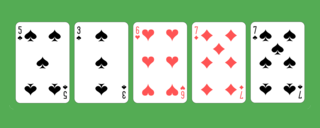
Decade or Ten-Twenty-Thirty is a Patience game of the Simple Addition family played with a traditional 52-card deck. It is akin to another solitaire game called Accordion, but during game-play three adjacent cards totalling 10, 20, or 30 can be removed.
Speed is a game for two players of the shedding family of card games, in which players try to get rid of all of their cards first. It is a form of competitive patience similar to Spit.
This is a glossary of conjuring terms used by magicians.
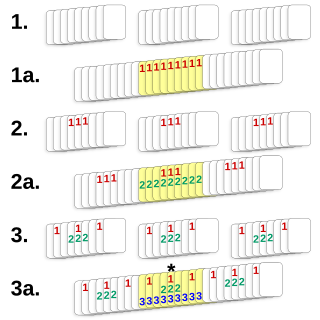
The Twenty-One Card Trick, also known as the 11th card trick or three column trick, is a simple self-working card trick that uses basic mathematics to reveal the user's selected card.
Spelling Bee may refer to one of several card tricks that revolve around the spelling of card types, audience member names, or words suggested by the audience. Many make use of decks prepared in advance in order to provide the illusion of spelling card names in a particular sequence. Jean Hugard's Encyclopedia of Card Tricks lists a number of such spelling-based tricks, many of which are considered to be self-working.
The Circus Card Trick is a self-working card trick where the performer uses verbal misdirection to prompt the participant into betting that the performer has failed to execute the trick correctly. The performer exploits the ambiguous wording of their patter to win the bet in a manner unexpected by the audience. It is often recommended for beginning magicians due to its entertaining and self-working nature.

Switch is a shedding-type card game for two or more players that is popular in the United Kingdom, Ireland and as alternative incarnations in other regions. The sole aim of Switch is to discard all of the cards in one's hand; the first player to play their final card, and ergo have no cards left, wins the game. Switch is very similar to the games UNO, Flaps and Mau Mau, both belonging to the larger Crazy Eights or Shedding family of card games.
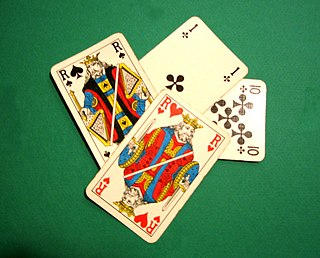
Twenty-eight is an Indian trick-taking card game for four players, in which the Jack and the nine are the highest cards in every suit, followed by ace and ten. It thought to be descended from the game 304, along with similar Indian games known as "29", "40" and "56".
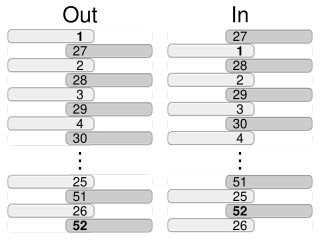
The faro shuffle (American), weave shuffle (British), or dovetail shuffle is a method of shuffling playing cards, in which half of the deck is held in each hand with the thumbs inward, then cards are released by the thumbs so that they fall to the table interleaved. Diaconis, Graham, and Kantor also call this the technique, when used in magic.
The Si Stebbins stack is a cyclic mathematical card stack. It was popularized by the magician Si Stebbins, and can be constructed from a standard 52-card deck. Frequently used in card magic, its properties allow the position and value of each card in a deck to be determined.

Tam cúc is a multi-trick card game popular in Northern Vietnam. Tam Cúc is not just played for entertainment, but also played in ceremonies and festivals. It is a card game that is commonly played in New Year celebrations, it a habit of northerner to play this game while wait for the bánh chưng to cook. Tam cúc is mostly played by women since the number of cards is much fewer than Tổ tôm, which is more common among men. It is similar to the games of Chēmǎbāo, Zhìhǔ, and Giog.
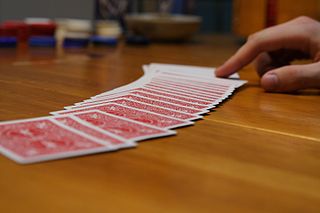
In stage magic, a force is a method of controlling a choice made by a spectator during a trick. Some forces are performed physically using sleight of hand, such as a trick where a spectator appears to select a random card from a deck but is instead handed a known card by the magician. Other forces use equivocation to create the illusion of a free decision in a situation where all choices lead to the same outcome.














